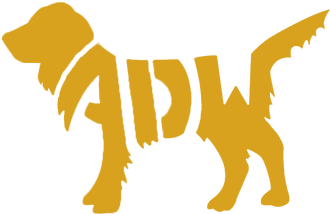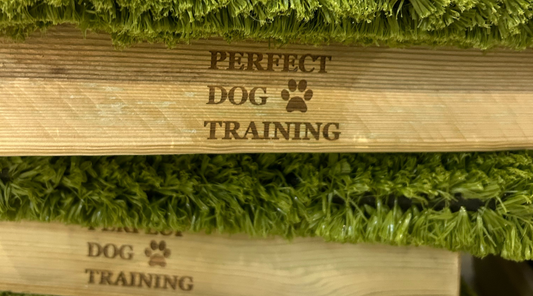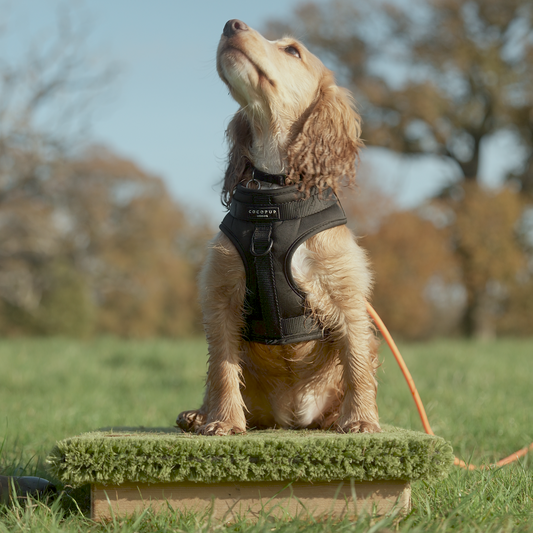Guide 2: How to teach your dog ‘Place’ using a Place Board
Our earlier post covers the first three stages of introducing the Place Board to your dogs' training. Check out the blog series by Clicking Here.
In this article, we cover how to teach the dog what we want them to do when we say “place” so that we can send them to their target from a distance.
You will need:
- Place Board.
- Lead and collar or harness.
- High-value food rewards cut into pea-sized pieces.
- Treats Pouch.
- Clicker (if using).
TIP: high-value food rewards include chicken/sausage/cheese/pate. It is advantageous if the food is light coloured like cheese when reward placement is on the ground the treat is easy for the dog to spot.
Handler setup:
- Have your dog on a lead.
- Keep your dog on your left.
- Hold the lead by looping the handle over your right hand.
- Cup your right hand to hold 5 treats.
- Hold the clicker in your right hand (if using).
- The right hand is held in line with your belly button.
- Left hand free to deliver treats.
Stage one: add the cue “place”.
Through associative learning, we will teach our dog what the word ‘place’ means by pairing them sitting on the place board with hearing us say the new cue ‘place’.
Part A: Teaching the cue
The dog is going to hear the word ‘Place’ as the behaviour happens:
- As the dog moves onto the board and into a sit, say ‘place’.
- Use a clicker or verbal marker as their bottom hits the board.
- Give 4 treats in a row with lots of praise. Throwing a 5th treat off the board onto the floor, paired with a release cue ‘OK’ to indicate the behaviour is complete.
- Let the dog have a break.
- Repeat several times to build up the association of the word to the behaviour.
Part B. Testing the cue
We are going to change the order so that they hear the word then the behaviour happens:
- As you walk up to the board, say ‘place’.
- The dog then moves onto the target and into a sit as you walk beside the place board.
- Use a clicker or verbal marker as their bottom hits the board.
- Reward as done in the previous step.
- Repeat several times to build up the association of the word to the behaviour.
TIP: only say the cue once. We want to teach the dog that ‘place’ means to go to the board and sit. If the word is repeated because the dog doesn’t respond the first time, they might be learning that ‘place place place place’ means go to the board instead! Rather than repeat the cue, if they don’t go to the board when you give the verbal cue, use a lure to guide them on and into a sit to create a behaviour you can reward and repeat ‘Part A. Teaching the cue’
Q: Have you had at least five successful repetitions in a row where your dog moves onto the board and into a sit when you say ‘Place’? Go to the next step.
STAGE TWO: Adding distance
In the previous steps we have been travelling with our dog, starting with the narrow end of the board in front of us and our dog using our momentum as we walk forwards and beside the long end of the board to encourage the dog forward onto the board.
To progress, we are going to teach the dogs to target and move onto the place board independent from us. To do this we will slowly increase the distance the dog has to travel without us beside them. Instead of moving next to the board as we did in the previous stages, we will stop in front of the board as we are walking towards it when we give them their ‘place’ cue.
Part A: Without walking beside the board
- Walk up to the narrow end of your place board with the dog on your left.
- Stop and say ‘place’ as your feet are in line with the end of the board.
- If they have learnt the behaviour, the dog will understand when they hear this, we would like them to move forward independently onto the board and into a sit.
- Mark and reward when they move onto it and sit.
- Send off the board with a treat and the release cue “ok”.
- Give them a break.
- Repeat these steps until the dog reliably displays independence and moves onto the Place Board without the handlers’ momentum to encourage them forwards at least five times in a row.
- If the behaviour isn’t offered, repeat the steps in ‘Stage one’ a little longer.
Part B: One step away from the Place Board.
- With the narrow end of your place board ahead, walk toward the board.
- Stop one step away from the board and say ‘place’.
- The dog will move onto the board and into a sit.
- Mark and reward as before.
- Send off the board with a treat and the release cue “ok”.
- Give them a break.
- Repeat these steps until the dog reliably displays independence and moves onto the Place Board without the handlers’ momentum to encourage them forwards at least five times in a row.
- If the behaviour isn’t offered, repeat ‘Part A’ a little longer.
Part C: Increasing the distance from the Place Board.
- With the narrow end of your place board ahead, walk toward the board.
- Stop two steps away from the board and say ‘place’
- The dog will move onto the board and into a sit. Mark and reward as before.
- Send off the board with a treat and the release cue “ok”.
- Give them a break.
- With each success, increase your starting distance from the place board by one step.
- If at any point you give the cue and the dog does not confidently move onto the target, go back to practising closer to the board until the behaviour is more established.
Goal to achieve: Repeat until your dog drives towards the target provided by the place board from 5 paces away.
TIP: when the dog is having a break and not training, flip the board over.
If you were to leave it upright, and the dog sits on it when you are not looking and you miss the chance to reward the dog, the dog might be unsure why they do not earn a treat.
Instead, because the underside looks different to the non-slip surface of the top we train with, if they sit on it and no reward is given, rather than undoing positive associations they will learn to ignore the wooden side and only target the non-slip surface when upright.
Overview:
- Add cue: as the dog moves onto the board and into a sit the handler says ‘Place’.
- Say 'Place' as you approach the board and walk up beside the long edge of the board.
- Say 'Place' as your feet are in line with the short end of the board.
- Say 'Place' when one step away.
- Continue to add steps with the goal being to able to say 'Place' and your dog goes to a Place Board 5 paces away.
About the author:
Hi 👋 I’m Emma, accredited as a professional dog trainer by the Institute of Modern Dog Trainers (IMDT). I help owners of energetic dogs achieve the dog-owning life they envisioned by providing robust obedience & agility training for dogs in Balsham, near Cambridge.
Disclaimer: The content of this article does not include personalised advice and is for information purposes only. If you need individual advice or other enquiries please click here to get in contact or if you're not local to Anglian Dog Works, you can find a trainer in your area by going to the IMDT website: https://www.imdt.uk.com/find-a-qualified-imdt-trainer
Please share your questions and progress:
We would love to see how you get on with your dog’s introduction to place boards. For tips from our trainer and to share success post your pictures and videos in the Anglian Dog Works Facebook group. https://www.facebook.com/angliandogworks




